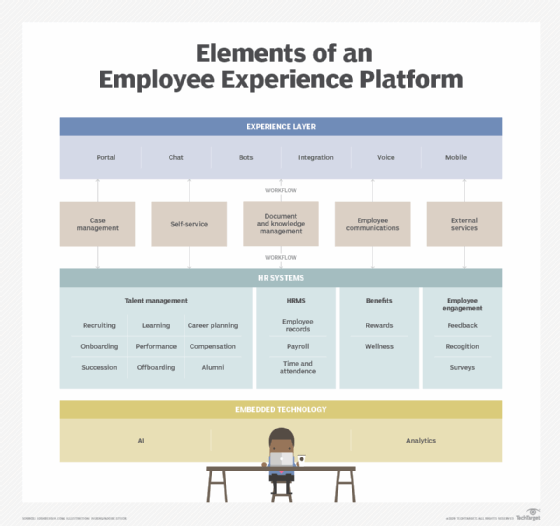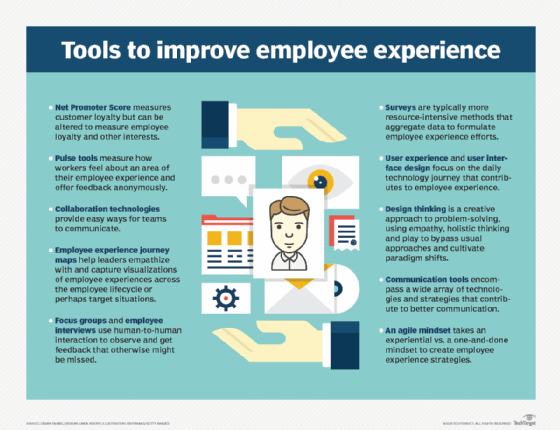6 ways to use technology to improve employee experience
Technology is only one component of the employee experience, but savvy deployment makes a difference. Here are some promising tools, and tips for fitting them into an EX strategy.
The employee experience was already the hot topic in HR before the COVID-19 pandemic pushed some companies to dive headfirst into executing employee experience strategies they otherwise would have waited to implement.
Employee experience technology plays a critical role in how employees feel about their day-to-day experience at an organization. It is still true that an effective employee experience strategy must include several major components besides technology, such as employee listening, HR policies and the physical workplace. And while the human touch is undeniably important, emerging technologies and digital transformation are crucial tools for business leaders to drive meaningful change in the employee experience and enhance the bottom line.
In addition to employee survey and listening tools such as Qualtrics and Medallia, the right performance management and talent acquisition software is also important to ensure employees have the right experience -- even before they become employees. Not only that, the other tools that are used in the business, from expense reporting to video conferencing, have a big impact on how employees experience their everyday work.
The importance of employee experience technology
Happy, engaged employees are more productive and less likely to leave. Customer-facing employees become ambassadors for their business and this, in turn, drives a better customer experience. Happy customers often make repeat purchases and continue the business relationship longer.
Even before the pandemic, many employers were looking at ways to better engage their workforce, improve employee retention and differentiate themselves in the constant battle to attract the best talent. Previously, companies had focused on things such as employee self-service and learning and development to engage employees. But many companies weren't gathering feedback across the workforce, listening effectively and analyzing this information. While there would be annual -- and sometimes more regular -- reviews and periodic touchpoints, the information from these events was typically more informal or couldn't be aggregated in a way that could be used for analysis. With modern tools, this is now possible.
Challenges implementing employee experience technology
As with any technology implementation, focusing too much on the technology and not enough on the business process and outcomes can lead to the wrong results. When implementing employee experience technology, it is important to focus on the outcomes and to understand what the employee listening strategy should be. When building employee surveys, it is important to write questions carefully so they match the strategy and produce the desired outcomes. Typically, companies need to bring in organizational psychologists and data scientists to help define outcomes and build out the corresponding questions.

It's also important to remember to consider the needs of everyone who works in the organization, including contingent workers, temps and other members of the extended workforce. While these types of workers are only with the organization on a temporary basis, many of them spend a significant amount of time working at the company. Engaging and including these types of workers and making sure that they share as positive an experience as their permanent counterparts will boost their productivity and help them blend into teams.
Many organizations operate in a siloed manner, but allowing this disconnected approach to get in the way of an employee experience technology deployment will have a dramatic effect on the success of the implementation. The employee experience impacts every worker, so cross-collaboration between different business units and departments is important to ensure that employee experience technology can be implemented effectively.
How to improve the employee experience with technology
The employee experience can be improved in many ways through the use of technology. It may be through a product that functions as a de facto employee experience platform (see the infographic) covering most of the touchpoints in the employee lifecycle in an integrated workflow across systems, such as ServiceNow. Or, it could be in a modern human capital management (HCM) suite that provides comparable functionality through the use of AI, chatbots and prepackaged employee journeys, such as Oracle Fusion HCM Cloud or SAP SuccessFactors HXM. The technology could instead be one of the more narrowly focused employee experience apps known to have the most impact, such as an intranet or a collaboration tool.
Here are six of the best strategies.

1. Implement an employee engagement technology
Technology dedicated to boosting engagement will be the cornerstone of an employee listening strategy and will directly influence the employee experience strategy. Gathering feedback from the workforce and analyzing the aggregated feedback trends over time to measure the employee experience will influence exactly what needs to be changed and help guide the steps to improve it. This could include collecting feedback on topics such as benefits options, a new policy or application that was rolled out, the existing application landscape or IT ticket-response times.
2. Improve productivity
One of the biggest winners for a business and the bottom line is to improve employee productivity. By using employee experience technology -- combined with an effective employee listening strategy -- and implementing organizational, policy and culture changes based on the feedback received, employees will be happier, more engaged and more productive.
3. Empower employees
Giving employees the autonomy, creative freedom and digital tools to do their job more effectively is a powerful way to provide employees with an experience that they will find exciting and rewarding. While creative freedom and autonomy come from policy and corporate culture decisions, providing employees with the tools to do their job is a technology decision that serves the same ends.
4. Review your portfolio of business applications
Not every aspect of improving the employee experience involves implementing employee experience technology. Every business application an employee uses impacts their experience. These applications can range from common systems such as time entry and expense management, conferencing and video software, and service delivery and ticketing tools to business-specific applications, such as an inventory management or content management system. Procuring the best applications, correctly implementing them and integrating them across the application landscape will make a significant difference in how employees work. Ensuring a consistent user experience across enterprise applications should also be a top priority.
5. Improve collaboration
Collaboration tools have become all the rage in recent years, and studies show they do, in fact, enhance the way employees work together. Tools such as Slack, Microsoft Teams and SAP Jam have been proved to make working together easier, which is something that employees welcome.
6. Optimize self-services
Self-service capabilities in HR and non-HR systems provide significant time savings for the business, but the applications must be simple to use. If the system requires significant effort, such as needing a manual or the help of a colleague, they often will not be used. Lack of use, in turn, brings data-integrity issues or motivates employees to seek workarounds that only redistribute the workload elsewhere. In some cases, an employee may only need to change their personal data, view their pay slip or look up another employee on the org chart. Ensuring that the system works well, can be accessed on mobile devices and has simple workflows that can easily be followed to completion will create easy wins.








